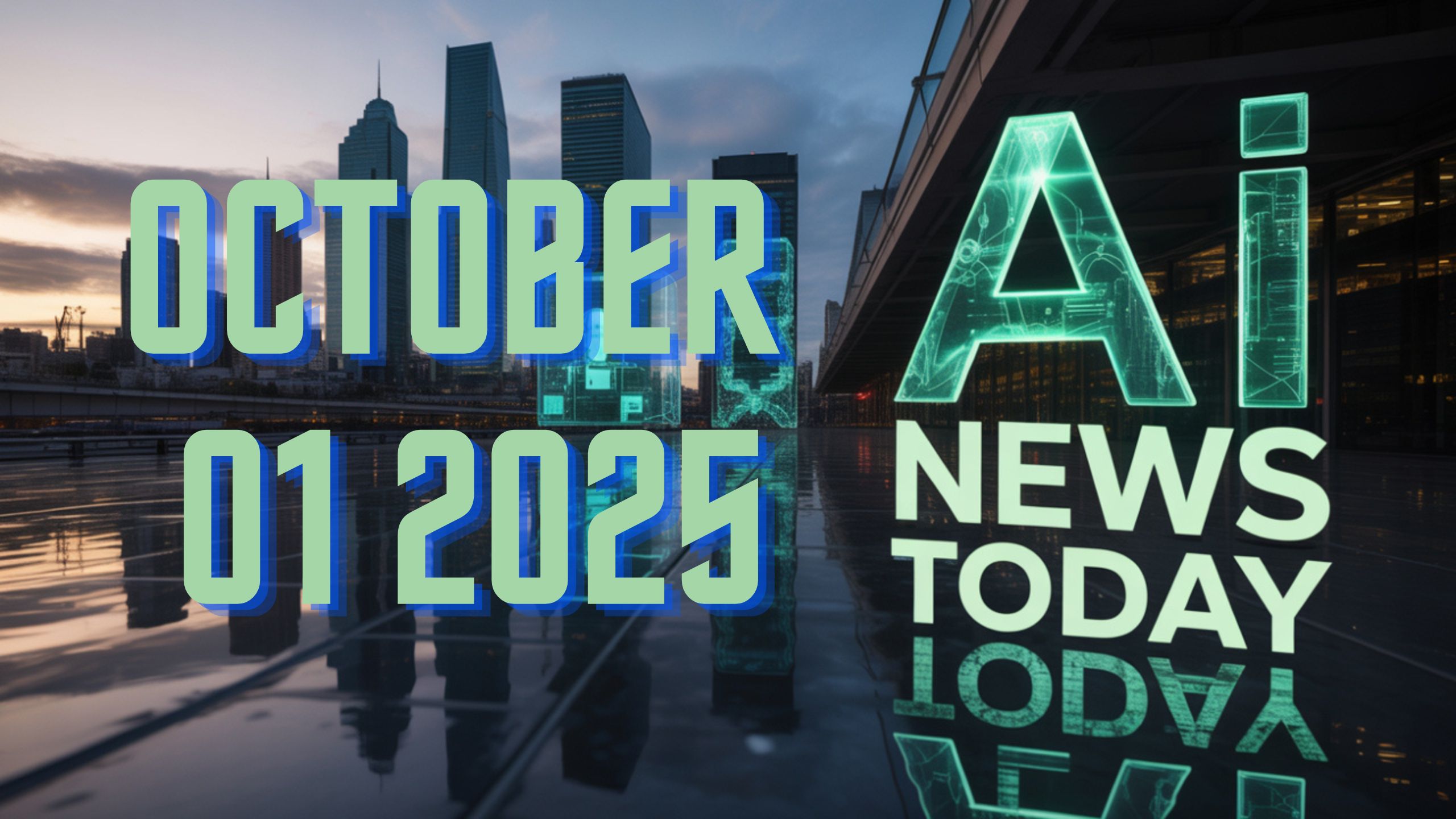AI News Daily — USA (Wednesday, October 1, 2025)– Artificial Intelligence continues to reshape the United States economy, government, and technological landscape at an unprecedented pace. From enterprise adoption of agentic AI to labor market disruptions, regulatory battles, and infrastructure expansions, the U.S. AI ecosystem is entering a decisive phase that will define its global competitiveness for years to come.
Enterprise and Agentic AI Momentum
This week, Kyndryl unveiled advanced “agentic AI” capabilities, enabling U.S. enterprises to deploy AI-native business architectures at scale. This announcement follows recent reports highlighting that agentic AI systems deliver superior growth trajectories and cost advantages compared to traditional generative AI models.
Enterprises across finance, retail, logistics, and manufacturing are already moving towards performance-linked deployments, which directly tie AI outcomes to measurable KPIs such as customer acquisition, operational efficiency, and revenue acceleration. The acceleration of enterprise AI maturity underscores a broader market trend: companies are no longer experimenting with AI, but are instead embedding it into their core architectures and value chains.
For U.S. leaders, this momentum is about more than automation—it is about reshaping the DNA of business operations to remain competitive against international rivals.
Labor Market: Escalating Job Loss Warnings
The U.S. labor market is bracing for massive disruption. Executives, including Anthropic’s Dario Amodei, Ford’s Jim Farley, and Walmart’s Doug McMillon, have issued direct warnings that up to 50% of entry-level white-collar jobs could be automated within the next few years.
Key job categories at risk include:
- Data entry clerks and administrative assistants
- Junior analysts in finance and consulting
- Customer service representatives in retail and healthcare
- Back-office staff across multiple industries
Generative and agentic AI systems are increasingly capable of handling data processing, customer interactions, compliance checks, and predictive analytics with speed and accuracy that surpass those of human workers. While government officials emphasize retraining initiatives and long-term productivity gains, the short-term panic is real: millions of U.S. workers face displacement unless reskilling programs scale rapidly.
The following 18–24 months will be decisive for the U.S. workforce as businesses balance efficiency gains with social and political pressures to safeguard employment.
AI Legislation and Federal Procurement Shifts
The regulatory environment for AI in the U.S. has undergone a historic pivot. The Trump Administration’s new executive orders replace the Biden-era framework with a more pro-innovation, fast-track model. Federal agencies are now instructed to:
- Prioritize AI acquisition that enhances mission readiness
- Implement minimum risk management standards rather than restrictive compliance-heavy models
- Enforce anti-lock-in provisions to prevent vendor monopolies
- Require baseline transparency practices for high-impact AI systems
Meanwhile, at the state level, California’s AB 489 comes into force today, giving healthcare boards the authority to audit AI-driven clinical applications directly. This legislation reflects mounting concerns about safety, accountability, and bias in critical domains such as medicine.
The combination of federal acceleration and state-specific safeguards signals a new regulatory balance: the U.S. is betting on speed and innovation while allowing localized oversight in sensitive industries.
Stargate Buildout: Expanding U.S. AI Infrastructure
The Stargate data center initiative—a joint project by OpenAI and Oracle—hit a significant milestone with the launch of Abilene’s flagship campus. Partnering with Crusoe Energy, the consortium announced that the first two buildings are now live, with five additional sites under development nationwide.
Key financing mechanisms include:
- Debt instruments for large-scale infrastructure
- Vendor-backed investments ensuring supply chain stability
- Equity-based partnerships to align incentives with cloud and AI providers
The Stargate project represents the backbone of next-generation AI deployment in the U.S., enabling the massive computational power required for agentic AI models, national security AI applications, and enterprise-scale workloads. With international rivals such as China scaling state-backed AI infrastructure, the U.S. is racing to maintain leadership through distributed hyperscale centers.
Platform Compliance and Copyright Enforcement
Intellectual property battles have intensified as Disney issued a cease-and-desist order against Character.AI, forcing the removal of its copyrighted content from chatbot platforms. This case signals a broader industry-wide reckoning:
- Content owners are demanding strict licensing agreements
- AI startups must navigate compliance frameworks or risk litigation
- Consumers may face restrictions on creative freedom as platforms tighten guardrails
This trend points towards a future where AI platforms cannot freely ingest copyrighted material without negotiated rights. Publishers, studios, and independent creators are lobbying for more explicit rules and stronger enforcement, which could reshape how generative and conversational AI models are trained and deployed in consumer markets.
Sector R&D, Science, and Major AI Events
The U.S. innovation landscape is alive with research and thought leadership. Recent highlights include:
- MIT’s new analysis on AI’s long-term labor impacts and business architecture design, offering insights into productivity models and reskilling strategies.
- The AIAA CTO Summit, which spotlighted adaptive AI systems in aerospace and defense, highlighted their role in mission-critical applications.
- Fujitsu’s October showcase of human-AI collaboration technologies emphasizing augmented intelligence systems designed to enhance, rather than replace, human decision-making.
These events underscore the multi-sectoral push for AI advancement, from academia and research labs to defense, manufacturing, and healthcare.
The Next Phase of U.S. AI Advancement
The convergence of enterprise adoption, labor disruption, regulatory reform, infrastructure expansion, and intellectual property enforcement marks the beginning of a new chapter in U.S. AI evolution.
- Enterprises are embedding agentic AI into their operating models at unprecedented speed.
- Workers face both disruption and opportunities in reskilling.
- Governments are adopting a two-track system: federal acceleration with state-specific guardrails.
- Infrastructure scale-up is providing the backbone for global AI competitiveness.
- IP enforcement is redefining the boundaries of generative and consumer AI.
The trajectory is clear: the U.S. is doubling down on AI as a strategic national priority, with every sector—from healthcare to aerospace—mobilizing to harness the benefits while navigating the risks.
Conclusion
As of October 1, 2025, the United States stands at the forefront of AI-driven transformation. The decisions being made today—in boardrooms, legislatures, and research institutions—will shape not only the future of the U.S. economy but also the global balance of AI power.
Ask Follow-up Question from this topic With Google Gemini: AI News Daily — USA (Wednesday, October 1, 2025)

Selva Ganesh is the Chief Editor of this blog. A Computer Science Engineer by qualification, he is an experienced Android Developer and a professional blogger with over 10 years of industry expertise. He has completed multiple courses under the Google News Initiative, further strengthening his skills in digital journalism and content accuracy. Selva also runs Android Infotech, a widely recognized platform known for providing in-depth, solution-oriented articles that help users around the globe resolve their Android-related issues.




Leave a Reply